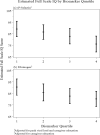Relationships between markers of vascular dysfunction and neurodevelopmental outcomes in perinatally HIV-infected youth
- PMID: 20539091
- PMCID: PMC2885052
- DOI: 10.1097/QAD.0b013e32833a241b
Relationships between markers of vascular dysfunction and neurodevelopmental outcomes in perinatally HIV-infected youth
Abstract
Objective: To examine the relationship between markers of vascular dysfunction and neurodevelopmental status in pediatric HIV disease.
Design: A cross-sectional design within a prospective, 15-site cohort study conducted in the United States.
Methods: Nine vascular biomarkers were examined in 89 HIV-infected children: soluble P-selectin/sCD62P, fibrinogen, adiponectin, monocyte chemoattractant protein-1/CCL-2, interleukin-6, C-reactive protein, soluble vascular cell adhesion molecule-1/sCD106, sE-selectin/sCD62E, and soluble intercellular adhesion molecule-1/sCD54. The Wechsler Intelligence Scale for Children-Fourth edition (WISC-IV) was administered yielding indices for verbal comprehension, perceptual reasoning, working memory and processing speed, and overall composite Full-Scale IQ score. Linear regression models were used to evaluate neurodevelopmental status (measured by WISC-IV scores) as a function of each biomarker while adjusting for demographics, disease severity, and receipt of HAART. Biomarker levels were evaluated in quartiles to evaluate trends in WISC-IV responses.
Results: Among the 89 HIV-infected children (median age = 12 years), 56% were girls, 71% black, 16% Hispanic, and 43% had yearly household income below US $20,000. Log (soluble P-selectin) was significantly correlated with all WISC-IV scores; adjusted slopes showed 6-11-point average decrease in scores for each one log unit increase in soluble P-selectin. Final linear regression models for log (fibrinogen) adjusted for sociodemographic and disease characteristics also indicated a negative correlation with all WISC-IV scores (13-30-point decrease for each one log unit increase in fibrinogen); these decreases were significant in the verbal comprehension, perceptual reasoning, and Full-Scale IQ scores.
Conclusion: Proinflammatory microvascular and immunologic mechanisms may be involved in neurodevelopmental impairment in children with perinatally acquired HIV disease.
Figures
References
-
- Tardieu M, Le CJ, Persoz A, Meyer L, Blanche S, Mayaux MJ. HIV-1-related encephalopathy in infants compared with children and adults. French Pediatric HIV Infection Study and the SEROCO Group. Neurology. 2000 Mar 14;54(5):1089–95. - PubMed
-
- Nozyce ML, Lee SS, Wiznia A, Nachman S, Mofenson LM, Smith ME, Yogev R, McIntosh K, Stanley K, Pelton S. A Behavioral and Cognitive Profile of Clinically Stable HIV-Infected Children. Pediatrics. 2006;117:763–770. - PubMed
-
- Mellins CA, Brackis-Cott E, Leu CS, Elkington KS, Dolezal C, Wiznia A, McKay M, Bamji M, Abrams EJ. Rates and types of psychiatric disorders in perinatally human immunodeficiency virus-infected youth and seroreverters. J Child Psychol Psychiatry. 2009 Sep;50(9):1131–8. Epub 2009 Feb 27. - PMC - PubMed
Publication types
MeSH terms
Substances
Grants and funding
LinkOut - more resources
Full Text Sources
Medical
Research Materials



